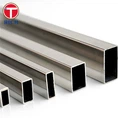How to make seamless steel pipe?
Jul 31, 2025
Leave a message
I. Production process of Hot-Rolled Seamless Pipe
- Raw Material Preparation: Select cylindrical, high-quality steel ingots or continuously cast round billets.
- Heating: The billet is heated in a furnace to its plastic deformation temperature (usually around 1200°C, depending on the steel grade), softening it and making it easier to work.
- Piercing: This is a key step in seamless pipe production. The heated billet is fed into a piercing mill (typically a cross-rolling piercer or a pressure piercer).
- Rolling: The hollow billet (called the rough tube) after piercing has uneven wall thickness and a rough inner surface, requiring further rolling to reduce the wall thickness, stretch it, and smooth its roundness. Commonly used equipment includes automatic pipe mills, continuous pipe mills, three-roll mills/Assel mills, pipe jacking mills, and extruders.
- Sizing: The rolled steel pipe (called the rough tube) must achieve a precise outer diameter and good roundness. This process is typically completed using a sizing mill (several two-roll mills) or a stretch reducing mill (multiple two- or three-roll tandem mills that create tension between the front and rear stands, simultaneously reducing the diameter and wall thickness). This process typically occurs at rolling temperature.
- Cooling: The rolled steel pipe is cooled to room temperature on a cooling bed or walking beam.
- Straightening: The cooled steel pipe may bend and needs to be straightened in a straightener.
- Trimming, Sampling, and Inspection: Irregularities at the pipe ends are trimmed, and samples are taken for testing of mechanical properties and chemical composition. Nondestructive testing (such as ultrasonic and eddy current testing) is also performed, along with hydrostatic testing, dimensional, and visual inspection.
- Packaging and Warehousing: Qualified products are spray-labeled, oiled (for rust prevention), and bundled for storage.

II. Production process of cold drawn/cold rolled seamless pipe
- Raw Material Preparation: Barrel or semi-finished tubes, typically produced by hot rolling, are used as the raw material (called tube blanks).
- Pickling: Surface scale is removed.
- Lubrication: Phosphating and saponification are performed on the tube blanks to reduce friction during subsequent drawing.
- Cold Drawing: One end of the lubricated tube blank is clamped and pulled through one or more die holes (dies) using an external force (chain or hydraulic tube drawing machine). The outer diameter is reduced, and the wall thickness may vary (controlled with or without a mandrel). Intermediate annealing is required to eliminate work hardening. Extremely long tubes can be produced.
- Cold Rolling: A multi-roll cold rolling mill (such as a two-roll cyclic cold rolling mill or a multi-roll cold rolling mill) is used. The tube blank is placed on a tapered mandrel and rolled back and forth through a variable cross-section pass, achieving a large deformation, extremely high dimensional accuracy, surface finish, and good wall thickness uniformity. Intermediate annealing is also required.
- Heat Treatment: After cold working, annealing, normalizing, quenching, tempering, and other heat treatments are performed according to product requirements to achieve the desired microstructure and properties.
- Finishing: Straightening, cutting, inspection (dimensional, surface, non-destructive testing, water pressure testing, etc.), and packaging.







